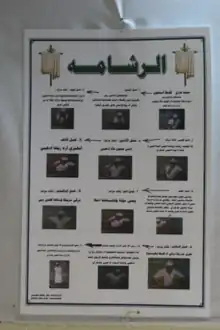Rishama (ablution)
In Mandaeism, rishama (rišama) is a daily ablution ritual. Unlike the masbuta, it does not require the assistance of a priest.[1] Rishama (signing) is performed before prayers and involves washing the face and limbs while reciting specific prayers such as the rushma. It is performed daily, before sunrise, with hair covered and after evacuation of bowels, or before religious ceremonies.[2]

1. Wash the hands
2. Wash the face 3 times
3. Wash the forehead 3 times
4. Wash the ears 3 times
5. Wash the nose
6. Wash the seat
7. Wash the mouth 3 times
8. Wash the knees 3 times
9. Wash the legs 3 times
10. Throw water on the head with the fingers of both hands
11. Dip right and then left foot in water
| Part of a series on |
| Mandaeism |
|---|
 |
| Religion portal |
Tamasha (ṭamaša) is another type of ablution performed by Mandaeans in which the entire body is fully immersed three times in water.[1]
Parallels
The ablution is comparable to wudu in Islam.
John D. Turner and other scholars have noted that in Sethianism, rituals reminiscent of Mandaean ablutions (i.e., the rishama and tamasha) are mentioned in Nag Hammadi texts such as the Trimorphic Protennoia, since they involve triple immersion in water, signing, and other similar features.[3]
See also
References
- Buckley, Jorunn Jacobsen (2002). The Mandaeans: ancient texts and modern people. New York: Oxford University Press. ISBN 0-19-515385-5. OCLC 65198443.
- Mandaean Awareness and Guidance Board (28 May 2014). "Mandaean Beliefs & Mandaean Practices". Mandaean Associations Union. Retrieved 26 November 2021.
- Smith, Andrew Phillip (2016). John the Baptist and the last Gnostics: the secret history of the Mandaeans. London: Watkins. ISBN 978-1-78028-913-7. OCLC 956946835.
External links
- The Worlds of Mandaean Priests (University of Exeter)
- Rishama (Ablution)
- Brakha and Rishama instructional video (in Arabic)
- Afternoon brakha and ablution in Amarah, Iraq

